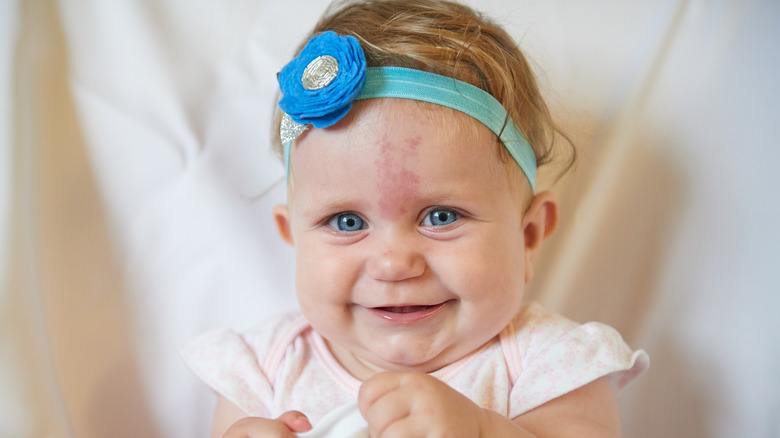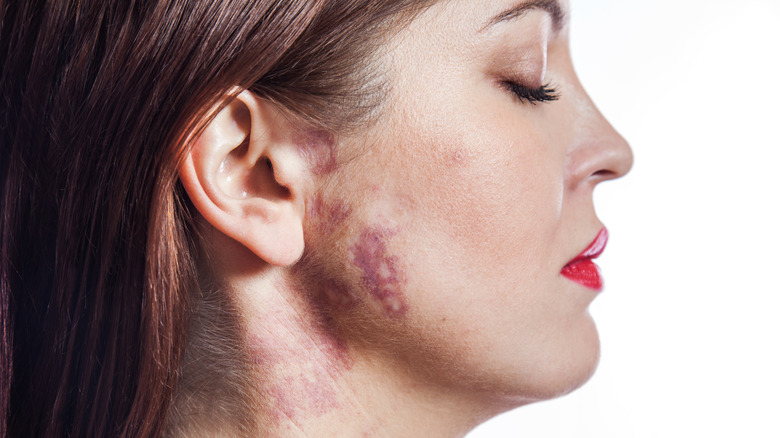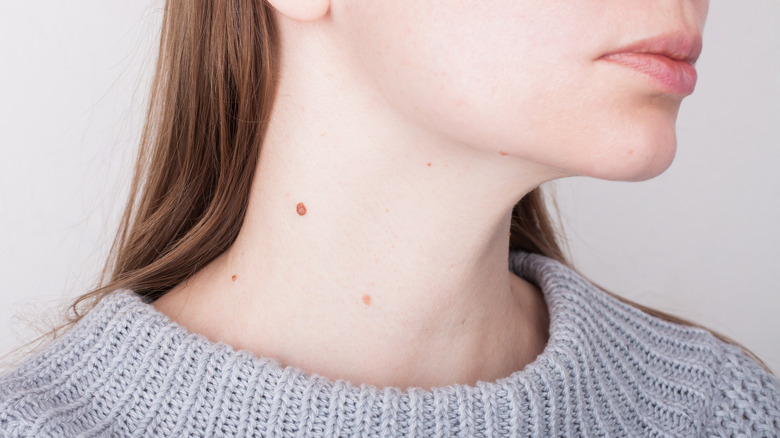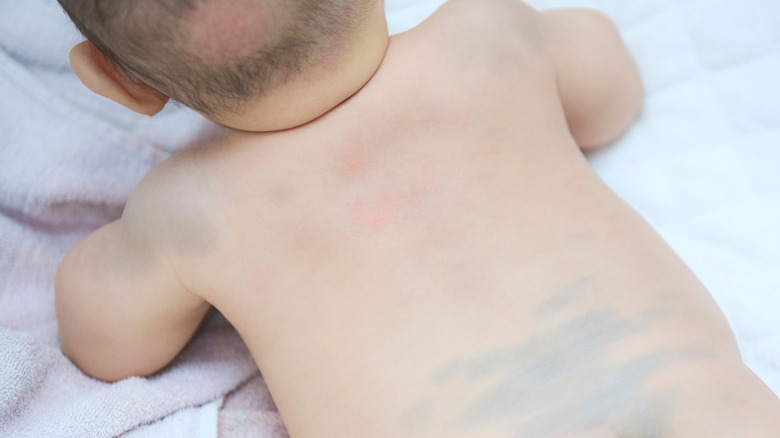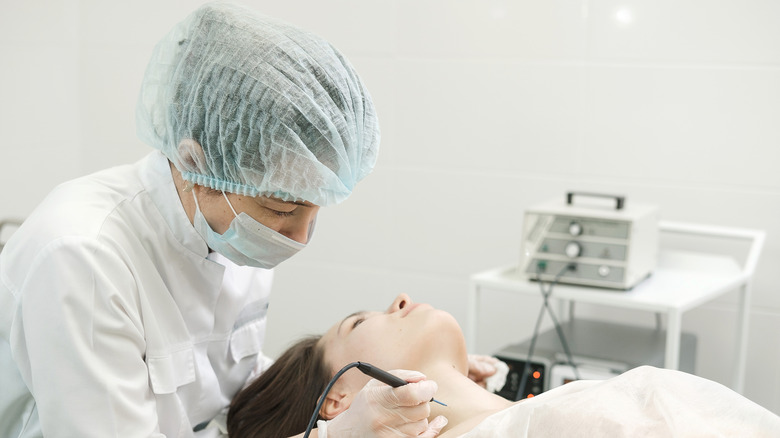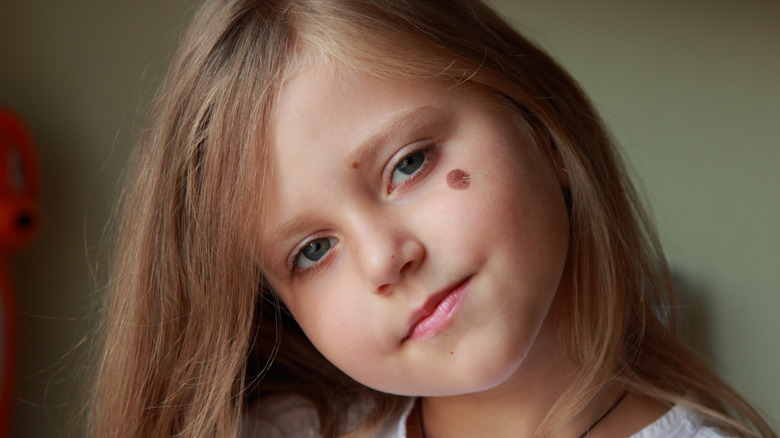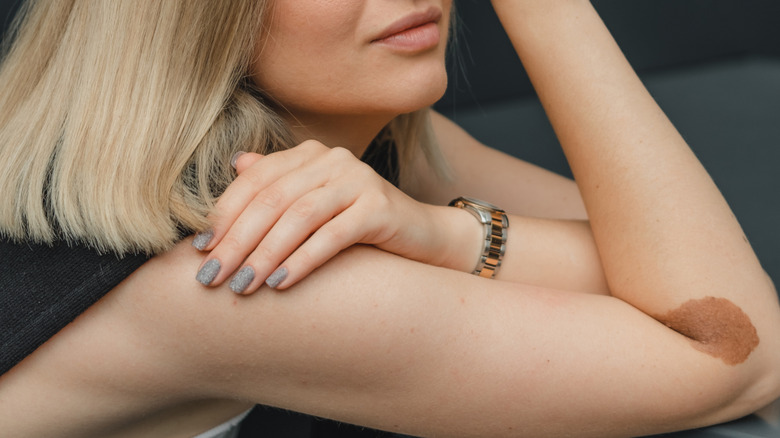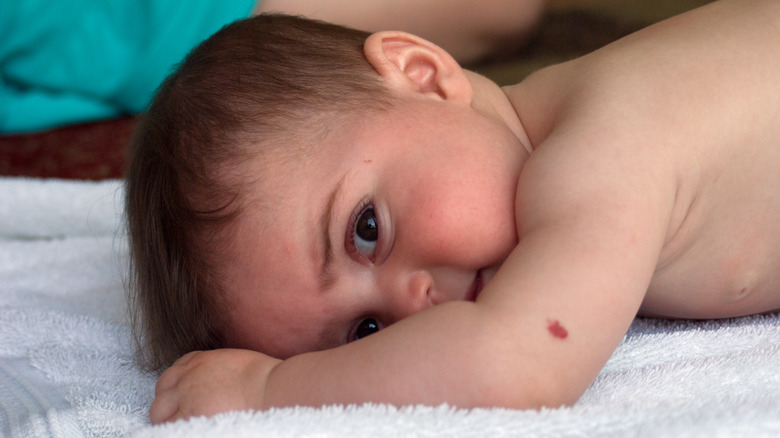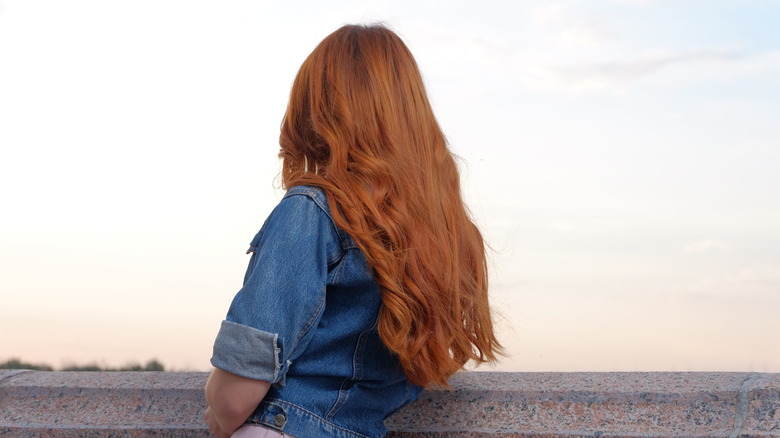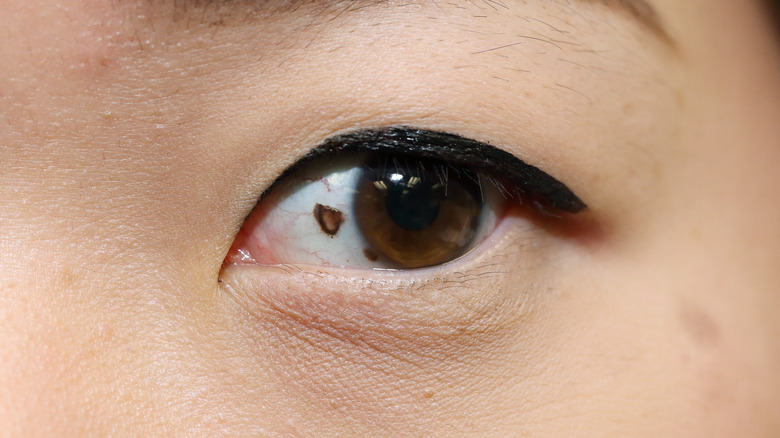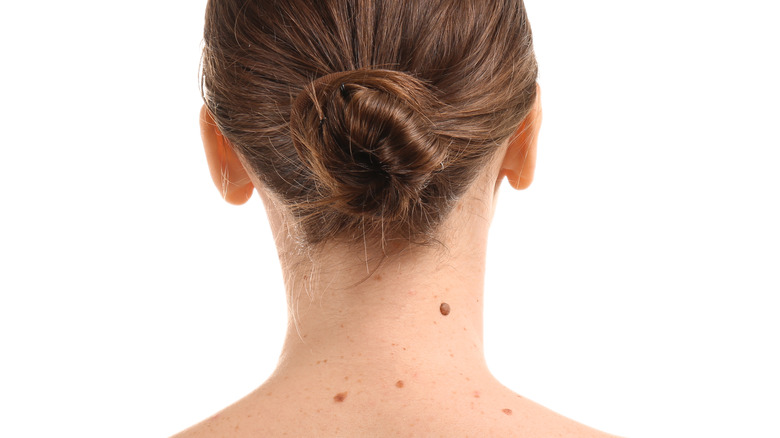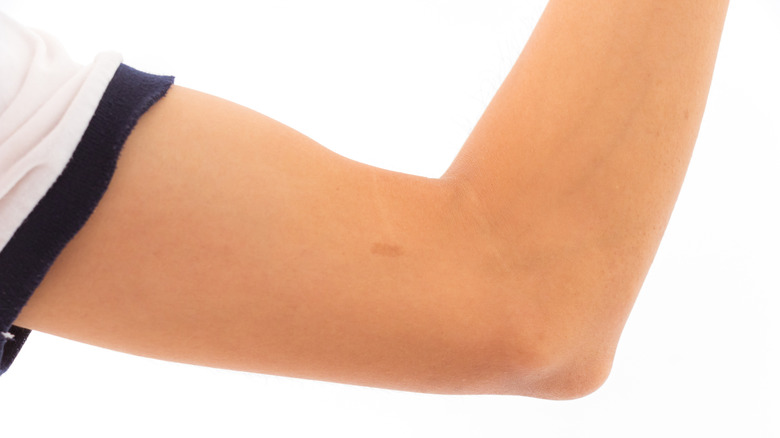The Untold Truth Of Birthmarks
Birthmarks can be found on over 80 percent of babies, according to BabyCenter. These marks are either present at birth or develop within a few months of a baby being born. If, like most people, you have a birthmark, it's probably not something you have given much thought to. Birthmarks are quite normal and very common, after all, so there's a good chance you often forget that you even have one. These seemingly simple patches of skin have a lot more to them than meets the eye, though. Birthmarks have long been a subject of fascination across the globe, and people have formed some interesting beliefs about them over the centuries.
Whether you have an interesting birthmark yourself or not, you will never look at birthmarks the same way again after you learn these fascinating details about them. From the science behind birthmarks to the superstitions that surround them, here is everything that you ever wanted to know about birthmarks.
There are more types of birthmarks than you probably realize
There are several types of birthmarks, and they can be broken into two major categories, according to Diseases and Disorders. First, there are red birthmarks, called vascular birthmarks or hemangiomas (derived from the Greek word "hema," meaning "blood," and "oma," meaning "tumor"). There are four main types of hemangiomas: pink or red strawberry birthmarks, maroon-colored port-wine stains, small pink spots called salmon patches or stork bites, and cavernous hemangiomas that are similar to strawberry marks but are typically deeper set in the skin and are of a reddish blue hue.
The second major category of birthmarks consists of pigmented patches of skin. These pigmented birthmarks include café-au-lait spots and Mongolian spots. Believe it or not, moles are also considered to be a type of birthmark — but only if you happen to be born with them. Moles that develop later in life are just moles and are not considered to be birthmarks. Moles can also be split into two broad categories of their own: flat and raised.
Scientists aren't entirely sure what causes birthmarks
Science has advanced a lot over the years, but it still can't tell us everything. Birthmarks are one of those things that, for one reason or another, are still puzzling the scientific community. According to the NHS, vascular birthmarks are the result of "abnormal blood vessels," while pigmented birthmarks are the result of "clusters of pigment cells." That explains how birthmarks get their color, but what causes them to form?
This is the part that scientists still can't definitively answer, although they do have at least a couple of possible theories about where birthmarks come from and why we have them. According to Diseases and Disorders, some research suggests that there are certain circumstances that correlate with birthmarks, including premature births, multiple births, and the use of fertility drugs. Medical News Today says that some doctors believe birthmarks are caused by a piece of placenta lodging itself into an embryo during pregnancy. Others think that placenta-produced proteins might increase the chances of developing certain birthmarks. None of these theories have been proven, however.
For now, at least, it looks like the question of how birthmarks form is one that will have to remain unanswered.
An old superstition blames mothers for birthmarks
Even though we don't know for sure where birthmarks come from, many cultures have attempted to solve the mystery. One of the most enduring myths about birthmarks links pregnant mothers with these mysterious marks. According to this common and widespread superstition (via The Atlantic), "if you have a food craving, and you don't fulfill that craving, and you scratch yourself, your child will be born with a beauty mark in the shape of the food you were craving." This legend persists in several countries including Israel, Egypt, Brazil, and Italy.
Baby Lore: Superstitions & Old Wives Tales from the World Over Related to Pregnancy, Birth and Babycare reveals that there are other legends that also blame the mother for birthmarks. According to a Chinese superstition, an expectant mother who starts a fire will give birth to a baby with a birthmark on their face. An old American superstition says that a baby will be born with a birthmark if a pregnant woman watches a lunar eclipse or if she touches her stomach during one. An Indian belief says that if a pregnant woman draws a line during an eclipse, that line will appear on the baby as a birthmark.
Some types of birthmarks fade with age
There are a couple kinds of birthmarks that almost always fade with age. One of the major birthmarks that typically disappears as a child ages is the Mongolian spot. This birthmark is often mistaken for a sign of child abuse because it is a bruise-like marking that covers a baby in a large blue or black patch. Mongolian spots are typically found in people with darker skin colors, and, according to Differential Diagnosis for Physical Therapists, they are "very common in children of Asian, African, Indian, Native American, Polynesian, or Hispanic origins." Mongolian spots almost always completely disappear by the time a child is 5 years old.
Strawberry birthmarks are another type of birthmark that typically fades as a child gets older. According to Diseases and Disorders, 95 percent of these kinds of birthmarks will be gone by the time a child is 9 years old.
Birthmarks are sometimes surgically removed
Not everyone likes having birthmarks, especially when they are in prominent locations such as the face. If their birthmarks aren't the type that fade over time, many will opt to have their birthmarks removed by laser or by surgery. Birthmark removal isn't always for aesthetic purposes, though. According to NYU Langone Health, in some cases, doctors will recommend that certain types of birthmarks be removed for medical reasons.
Some types of birthmarks that form on the scalp can lead to a bald spot, prompting removal. Moles are another type of birthmark that are often surgically removed. Some deep hemangiomas can damage the skin around them. A hemangioma on the face, for example, has the potential to damage the eyes, nose, and mouth. Such birthmarks also run the risk of affecting a child's self-esteem, which is another reason that a doctor may recommend surgical removal.
Doctors recommend that birthmark removal occur when a child is still young, as their skin is more elastic then and therefore heals more readily, minimizing scarring.
Birthmarks are typically harmless
While many people may be self conscious of their birthmarks, the good news is that they are completely normal and, for the most part, harmless. Sometimes, though, birthmarks can be an indicator of a disease. Children who have a congenital nevus (a dark mole that is usually located on the body's scalp or trunk) for example, have a higher risk of skin cancer as adults, so these types of birthmarks should be monitored by a medical professional throughout the child's life, says the Mayo Clinic.
Children with port wine stains sometimes also have Klippel-Trenaunay syndrome (which affects blood vessel development) or Sturge-Weber syndrome (which is often characterized by seizures or convulsions), so these birthmarks should also be examined by a doctor.
Woman's Day notes that you should always monitor moles and birthmarks for signs of change. If you see anything unusual, you should make an appointment with your doctor.
Some types of birthmarks may run in families
Birthmarks aren't hereditary... usually. Again, science can't give us many answers here. "Some birthmarks run in families," Dr. Hardick Soni told Insider. "However, scientists are not completely sure why birthmarks only affect some babies, or why they develop in the first place." This less-than-satisfying answer confirms again just how mysterious birthmarks truly are.
According to Better Health Channel, birthmarks can run in families or be "similar to marks on other family members," but most birthmarks aren't hereditary.
Hereditary birthmarks play a key role in ancient Greek literature. According to A Companion to Families in the Greek and Roman World, the founder of the Seleucid dynasty, Seleucos, was said to be the son of the god Apollo and supposedly had an anchor-shaped birthmark on his thigh that was considered proof of his link to Apollo. According to the myth, Seleucos passed this birthmark on to his descendants.
Birthmarks have sometimes been associated with evil
Some of the many superstitions surrounding birthmarks are downright sinister. According to Black Cats & Four-Leaf Clovers: The Origins of Old Wives' Tales and Superstitions in Our Everyday Lives, birthmarks were once thought to be a sign that a mother had done something evil.
In the 17th century, an English man named Matthew Hopkins outlined a guide to catch witches called The Discovery of Witches. According to Connecticut Witch Trials: The First Panic in the New World, one of Hopkins' supposedly surefire ways of identifying a witch was to search for a "devil's mark." All witches were thought to carry such a mark, and people determined to prove someone was a witch could claim that any mark upon the skin of an accused witch was a devil's mark. A birthmark could be all the proof that was needed to condemn someone as a witch. Hopkins' guide resulted in hundreds of deaths both in England and in the Americas.
Historically, there have been some pretty wild beliefs about birthmarks
According to Black Cats & Four-Leaf Clovers: The Origins of Old Wives' Tales and Superstitions in Our Everyday Lives, there are some societies that think a birthmark is an omen of luck. If, for some reason, you don't want a baby to have a birthmark, one superstition says that if a mother licks her child's birthmark, she can make it disappear. In the past, mothers were also urged to rub their bodies with black pepper to prevent their babies being born with birthmarks.
According to Baby Lore: Superstitions & Old Wives Tales from the World Over Related to Pregnancy, Birth and Babycare, birthmarks shaped like crosses or doves signify that a baby is blessed. Babies who have birthmarks on their heads with blonde hair have been given a lucky kiss by either a fairy or an angel. Another belief says that if a baby has a mole, they will be successful in the future. An Indian superstition says that a wheel-shaped birthmark is a lucky sign and that it's even luckier if the birthmark appears on the right side of the body.
Some people think birthmarks are evidence of past lives
One of the more intriguing theories about birthmarks is that they are proof that reincarnation exists. This theory isn't just rooted in superstition, either, but has actually been scientifically examined. According to the abstract of a paper by Dr. Ian Stevenson titled "Birthmarks and Birth Defects Corresponding to Wounds on Deceased Persons," about 35 percent of children who claim that they remember having lived past lives have either birthmarks or birth defects on their bodies that correspond to wounds supposedly suffered in a past life.
Stevenson investigated 210 of these past life claims by tracking down the person whose life a child claimed to remember. He found that "in cases in which a deceased person was identified the details of whose life unmistakably matched the child's statements, a close correspondence was nearly always found between the birthmarks and/or birth defects on the child and the wounds on the deceased person."
For Stevenson, this was indisputable proof of reincarnation. "Some paranormal process seems required to account for at least some of the details of these cases," concluded Stevenson.
Birthmarks can sometimes be found in the hair
While a birthmark is, by definition, something that appears on the skin, it's not the only distinguishing feature that can be present at birth. According to Medical News Today, birthmarks can affect the hair, sometimes causing a white lock of hair. This shock of hair is referred to as a Mallen Streak, and is caused by a condition that causes a lack of pigmentation in hair called poliosis. These locks of white hair can run in families. In 2018, Metro shared the story of Josiah Barnes, a 2-year-old with a white patch of hair in the middle of his head. Barnes is one of about 40 people in his family to have this distinguishing mark. "It runs through my family," said his mother. "We don't know where it originated but my grandmother had it as did her grandparents."
In 2016, Kidspot shared the story of a woman named Brianna Worthy who passed her own white streak of hair on to her daughter. Worthy's mother and grandmother also have a white streak of hair.
Birthmarks can also be found in the eye
Another distinguishing mark that is similar to a birthmark is a choroidal nevus. A choroidal nevus is not technically a birthmark (although it's often referred to as such) but is actually a spot, freckle, or mole in the eye. Many people don't know they have them and they're typically discovered by doctors during eye exams.
While having a birthmark floating around in your eye might sound painful, Verywell Health assures that choroidal nevi are normal and don't usually indicate any health problems. In some cases, though, they can grow large enough that they disturb the surrounding tissue, leading to fluid or blood leaks or even retinal detachment.
According to the Kellogg Eye Center, choroidal nevi are quite common and five to ten percent of the population have them. If you have one of these marks, you should keep an eye on it and have it examined annually so a doctor can monitor it for any changes.
Moleomancy is a type of fortune-telling based on birthmarks
There are some people who think that a fortune can be told through birthmarks, specifically moles. The practice of telling mole-based fortunes is called moleomancy. According to Dreaming the Future: The Fantastic Story of Prediction, this practice may have originated with the Chinese, but telling fortunes through moles was also practiced by the Roma. According to the moleomancy practiced by the Roma as they traveled through Europe, a round mole is a sign of good luck. If you have one with angular sides, molemancy suggests that you have a "fiery temper."
According to The Encyclopedia of Superstitions, the practice is also referred to as molescopy. The placement of moles can supposedly reveal a lot about a person. If you have moles on your ears, you will one day become wealthy. A mouth mole indicates someone who is full of passion. If there are many moles on your breasts, it means you'll one day have many children. Moles on your buttocks indicate a lazy nature. According to moleomancy, the darker a mole is, the more significant it is, and therefore a darker mole means that these signs are more likely to be true.
Where a birthmark is on your body can reveal a lot about you
According to Dreaming the Future: The Fantastic Story of Prediction, the practice of telling fortunes based on other types of birthmarks besides moles is called maculomancy. Birthmarks, according to those who believe in this practice, mean different things based on where they are found on your body.
According to Baby Lore: Superstitions & Old Wives Tales from the World Over Related to Pregnancy, Birth & Babycare, Portuguese superstition says that if a baby is born with a birthmark on their leg, it is a sign that their feet are itching to travel or that they will be hyperactive. A birthmark on the arm, on the other hand, means that the bearer is going to grow up to be strong. A birthmark appearing on the face is considered to be a sign of beauty.
Whether or not you actually believe that birthmarks can reveal anything about a person, maculomancy can be a fun party trick to impress your friends.
